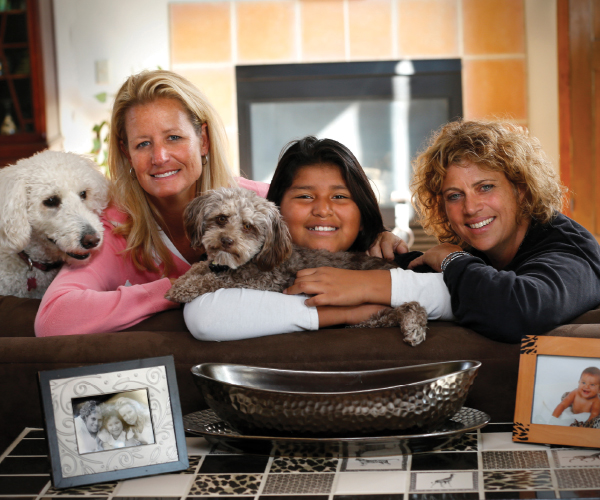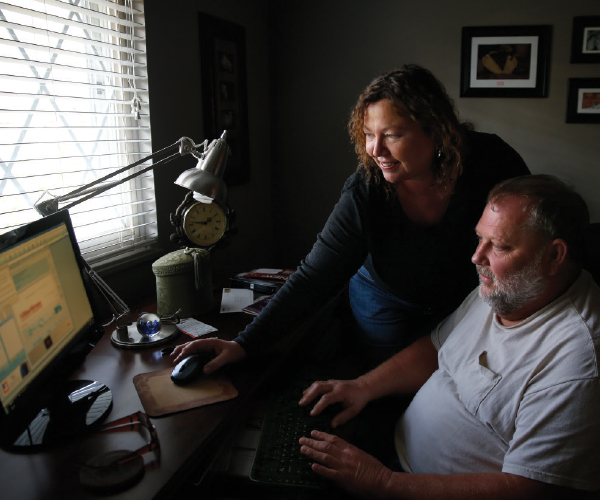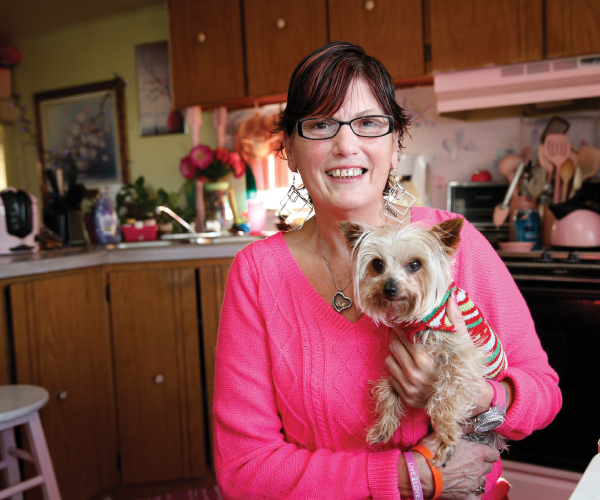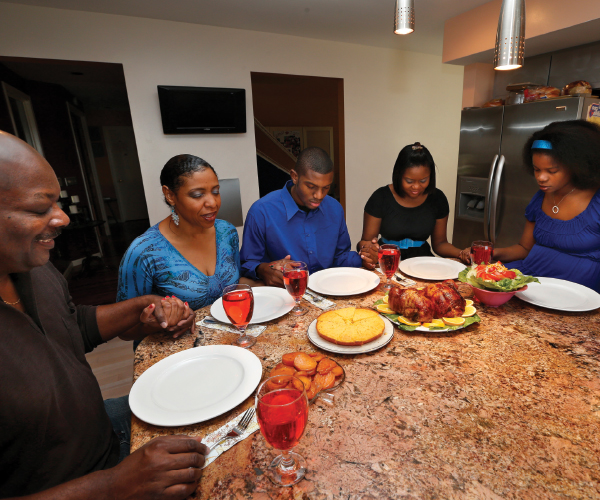

State of the American Family
by Terri Carroll '88
Today’s American family does not have the same structure as a generation ago. Rapid social, cultural and economic changes have transformed families and contributed to greater complexity and diversity. A household headed by a married mother and father who are both the biological parents of their children is no longer the most common version of today’s family; in fact only about 15 percent of American children now reside in a traditional breadwinner-homemaker family. Other changes include dramatic rises in cohabitation among adults over age 50 and the number of adults age 45 to 63 who are unmarried. BGSU researchers offer a lens to view how families have changed in recent decades and what these changes might mean for our society.

Dr. Jodi Haney and Lisa Addis have a vibrant 10-year-old daughter named Kiki. While a gay couple with an adopted child may not fit the mold of what Americans traditionally consider a typical family, the research of BGSU faculty shows that this family reflects new trends that define the contemporary American family.
“We’re in the midst of a major change in the way families and marriage are organized,” said Dr. Susan Brown, BGSU professor of sociology and co-director of the National Center for Family and Marriage Research (NCFMR). “The typical American family does not have the same structure as a generation ago. Social and economic dynamics have contributed to greater complexity and diversity in today’s families. A household headed by a married mother and father who are both the biological parents of their children is no longer the most common version of today’s family.”
Most of the time, the Haney/Addis clan do not think of themselves as a new kind of family. “We struggle and celebrate the same kinds of things as many American families — balancing school, work and play, taking care of extended family, managing finances and trying to provide the best life for our daughter,” said Haney.
“Leave It to Beaver”
A challenge for today’s contemporary families is the great myth of the 1950s, an era in which 60 percent of families consisted of a breadwinning father and a stay-at-home mother. Nothing represents this ideal more iconically than the popular television show “Leave it to Beaver,” which depicts the Cleaver family as the idealized, white, middle-class, suburban family. The pervasively popular show captures an ethos that was actually a 15-year-aberration, fueled by post-World War II prosperity, remarkable economic growth and social stability. Only about 15 percent of American children now reside in a traditional breadwinner-homemaker family.
“It’s not surprising that we cling to the nostalgic myth of what an American family should look like,” said Brown. “But the era represented by ‘Leave it to Beaver’ is long gone, reflecting rapid social, cultural, and economic changes. We have more options today. There is no longer one, uniform model of family life,” says Brown.
Researchers at the NCFMR, which is housed at BGSU and funded through a cooperative agreement with the U.S. Office of the Assistant Secretary for Planning and Evaluation, investigate how families have changed in recent decades. They ask key questions about the effects of family structure and processes on the health and well-being of families, adults, children and communities as well as the influence of programs and policies on marriage. The NCFMR is also dedicated to expanding research capacity across multidisciplinary networks of scholars, including students, and sharing results with broad audiences.

“Modern Family”
Findings from the NCFMR indicate that the majority of today’s families look less like the Cleaver family and more like the television series “Modern Family.” This hit program shows the changing face of the American family with a gay couple that has an adopted child, interracial families, remarriages and stepfamilies, cohabitations and a traditional two-biological married parent family.
“What is interesting about this show is that it features a range of family types, illustrating the diversity of families in America today,” said Dr. Wendy Manning, BGSU professor of sociology and NCFMR co-director. “It is important for family researchers to examine all family forms to help shape more comprehensive, effective policy prescriptions.”
For example, sociology master’s student Sarah Burgoyne recently took a closer look at data about same-sex couple households and found those households often include children. According to her research, one in six same-sex couple households includes children.
“As the number of children living with same-sex parents continues to grow, it will be increasingly important for us to understand the demographic profile of these households,” Burgoyne said.
The changing face of cohabitation
One of the most pervasive trends identified by the center is that more adults age 50 and older are choosing to live with their significant other instead of marrying. BGSU researchers found that cohabitation among adults over age 50 more than doubled, from 1.2 million in 2000 to 2.75 million in 2010.
According to Brown, lead author of the study, most prior research on cohabitation focused on young and middle-aged adults, essentially ignoring the experiences of older adults. “The retreat from marriage is evident among older adults, who increasingly favor cohabitation over marriage,” said Brown.
Take the example of Kathy Bloomfield. She is a baby boomer who has happily lived with her partner, Tom Chambers, for sixteen years. She said, “Living together is the perfect solution for us. We have the benefits of marriage such as companionship, love and caring, without the potential risks, like mixing our financial and legal matters.”
Another myth-busting finding from center researchers contradicts the famous “cohabitation effect,” a sociological finding from the 1980s that indicates couples who live together before marriage are more likely to get divorced. Recently Manning analyzed couples married since 1996 and found that the cohabitation effect “…has almost totally faded. We just can’t detect it anymore.”
In fact, it turns out living together is a strong pathway to marriage. Among young adults who got married, more than three-fifths cohabited before tying the knot.
“Today, most marriages are preceded by cohabitation,” Manning said. “It’s really become a stage in the courtship process.
It’s unusual for couples to marry without first cohabiting.”
Pathways to adulthood
In addition to studying young adult cohabitation trends, the NCFMR is conducting a five-part study, “On the Road to Adulthood,” which looks at the experiences of young adults through age 25. Among the findings:
- A majority (61 percent) of young
adults have formed a family — defined as having a child, getting married or cohabiting with a romantic partner —
by age 25. - More than a quarter of young adults married prior to their 25th birthday.
- Young adults with at least a bachelor’s degree were most likely to follow a “traditional” marriage path.
- Those with a GED or without a high school diploma were more likely to cohabit or have a child before marriage.
- One-third of young adults have had a child and more than one in three of them did so before cohabitation or marriage.
- At only 2 percent, it’s rare for young adults with at least a bachelor’s degree to have a child pre-union.
- About one-fifth of young adults without a diploma or degree or with a GED have had a pre-union birth before age 25.
This research was conducted by Dr. Krista Payne an NCFMR social science data analyst who earned her B.A., M.A. and Ph.D. degrees from BGSU. She says these patterns showcase the educational divide in family patterns in the United States. “Young adults with the lowest economic prospects are least likely to follow the traditional family patterns. These data have powerful public health and policy ramifications,” said Payne.

Educational divides and family stress
Educational divides in family patterns are also reflected in research by Dr. Kei Nomaguchi, associate professor of sociology, concerning the role of education in influencing stress for mothers.
It has been documented that mothers with a lower level of education experience more parenting stress since their families often struggle with access to resources. Working with Brown, Nomaguchi also found that mothers with a four-year college degree or more suffer from similar levels of stress in parenting, albeit from different sources.
“Mothers in both ends of the educational scale share similar views: U.S. society today is a more dangerous environment for children than when they grew up; and mothers should be involved in children’s lives,” said Nomaguchi. “These views cause mothers with lower levels of education more stress, as they may not have access to safe neighborhoods, good schools for children, or flexible work schedules that allow them to be home when children come home from school. In contrast, highly educated mothers experience stress because they invest a lot of time and energy in parenting to foster their children’s talents and skills, while they feel pressure to be occupationally successful. It’s a very difficult balance to make.”
Additional research conducted by Nomaguchi indicates that family stress is also divided by gender. Fathers today report wanting to spend more time parenting and feel more torn between work and family responsibilities than fathers in the 1970s. But fathers are much less likely than mothers to feel guilty and suffer emotionally when they do not meet this goal. “Fathers are increasingly feeling obligated to help out, but it is still mothers who take the primary child-care responsibilities,” said Nomaguchi.
First-time divorce rate tied to education, race
Educational divides also play a central role in new research from the NCFMR that shows substantial variation in the first-time divorce rate when it is broken down by race and education. But there is also evidence that a college degree has a protective effect against divorce among all races.
Among women in a first marriage, the rate of first divorce is highest for those who received some education after high school, but have not earned a bachelor’s degree — 23 per 1,000. The association between education and divorce is also curvilinear. The least (no high school diploma or GED) and the highest (college degree) educated women share the lowest rate of first divorce.
The association between education and the first-divorce rate remains consistent when factoring in race and ethnicity.
Facing old age alone
Understanding divorce patterns is important as startling new statistics from the center paint a bleak future for the largest generation in history, the baby boomers, as they cross into old age.
Dr. I-Fen Lin, an associate professor of sociology, and Brown found one-third of adults aged 45-63 are unmarried. This represents a more than 50 percent increase since 1980, when just 20 percent of middle-aged Americans were unmarried.
Lin said these unmarried boomers tend to be more vulnerable economically, socially and physically than their married counterparts. “They’re more likely to be poor and to be using public assistance, and they’re less likely to have health insurance but more likely to have a disability,” she said.
Kathy Mockensturm agrees that being alone makes you more vulnerable as you head toward old age. “I have never been married, so have learned to manage everything on my own,” she said. “This is definitely challenging when facing any kind of health or financial crisis. I see that my friends who are married have someone to help them when times get rough, and I wonder who I will turn to as I face the inevitable complications in the years ahead.”
“This all raises questions about who is going to provide for them as they become frail and infirm. And the answer is not entirely clear,” said Brown. “In the past, family members, particularly spouses, have provided care to older adults. But a growing share of older adults aren’t going to have a spouse or child available to rely on for support. These shifting family patterns portend new strains on existing institutional supports for the elderly. As more singles enter older adulthood, who will care for those people, how will the emotional and financial costs of that care be shared — and what can society do to prepare for this demographic tsunami?”

Everyone has a family
The data, and questions that arise from the findings, clearly captivate the American public. The work of Brown, Manning and their NCFMR colleagues has been featured extensively in both broadcast and print media, from ABC News to USA Today and The New York Times, with more than 100 references during the past year. When asked why their research has gained such exposure, Manning answered simply, “Everyone has a family. As the primary organizational group in our society, people are aware that healthy families are key to a healthy society. People sense intuitively that families are evolving and, therefore, are interested in our findings.”
Families and Spirituality
The importance of families in American society sent Dr. Annette Mahoney, BGSU professor of psychology, on a quest to determine the link between spirituality and healthy families.
Because almost 90 percent of Americans identify themselves as religious or spiritual, Mahoney wondered what effect spirituality had on families’ health. To her surprise, she found that most studies over the past 30 years were based on questions about religious affiliation, religious attendance and overall perceived importance of religion. These data reflect narrow questions about the spirituality of individuals — the spirituality of “me” — rather than the link between family life and faith — the spirituality of “us,” or relational spirituality.
“I wanted to expand beyond questions like how often one family member attends religious services,” said Mahoney. “I thought the research should capture the complexity and depth of relational spirituality, and identify specific spiritual beliefs and practices about family life that can help or harm marriage or parenting.”
Mahoney is the lead investigator on a team funded by a $1.2 million, four-year grant from the John Templeton Foundation that also includes Dr. Kenneth Pargament, professor of psychology, and Dr. Alfred DeMaris, professor of sociology. Additionally, almost 100 undergraduate and graduate students have contributed to the project.
The team collected four waves of data on 164 married couples having their first baby. They assessed specific spiritual beliefs about marriage and parenting, and shared spiritual activities between spouses.
One key finding involved couples’ reports of how much they honestly disclosed and nonjudgmentally listened to each other’s spiritual struggles and joys as they transitioned from being a couple to a family. Couples who said they had more spiritual intimacy treated each other better, based on observations of videotaped marital interactions. Both spouses displayed more warmth and love, less hostility and better communication skills over repeated observation sessions from the time they were pregnant until their baby was a year old. Interestingly, the couples didn’t need to share the same spiritual beliefs, they only needed to be open to sharing and listening.
“It is rare in family research to link what couples say about themselves to observations of their actual behavior in a longitudinal fashion,” said Katie Kusner, a graduate student who used results from the study as the basis for her dissertation. “Even when we control for personality traits, intelligence, education, and other stable characteristics of couples, we get the same results.”
Mahoney comments that “couples who have a deep spiritual connection with each other may be more motivated to remain kind and resist the urge to ‘go negative’ when they discuss their core conflicts.” A similar key finding was that couples who view their marital relationship itself as sacred are more likely to be positive in their marriages in ways that are measurable and beneficial.
Mahoney and her team also investigated what spiritual beliefs and behavior between spouses might do harm. They found the most harmful behavior was what they called “spiritual one-upmanship.” This is a pattern whereby one partner acts as if he or she is spiritually superior and God is on their side during conflicts. Although relatively rare, using faith as a weapon during marital disputes is tied to more marital problems.
Training the Next Generation of Scholars
It’s not just BGSU faculty who are generating cutting-edge research Undergraduate and graduate students play a central role, too, with NCFMR hosting dozens of students each semester.
Junior Seth Williams said, “Working at the NCFMR has been an incredible asset to me as a student of sociology. Not only have I been afforded insight into the real work of family and demographic researchers, but I have also gained the basic skills necessary to contribute to meaningful research at the center myself. Working under the guidance of some of the top family scholars in the field has significantly enhanced my educational experience at BGSU. I fully expect that my time here will be instrumental in my continued development as a researcher in the social sciences.”
“Historical changes in U.S. families have been dramatic,” Brown said. “Family life shifted as we moved from a rural, agrarian society to an urban, industrialized economy. Economic, demographic, and cultural changes continue to shape family experiences. This is an exciting time to be studying families because they are changing so rapidly today.”
Updated: 07/13/2020 03:30PM
